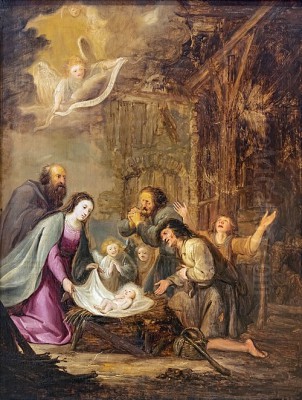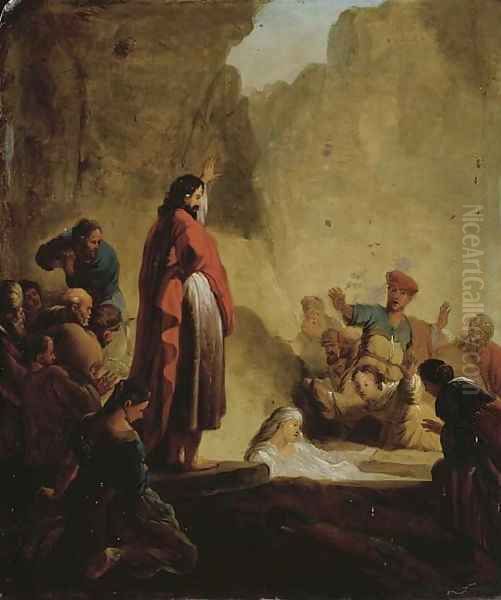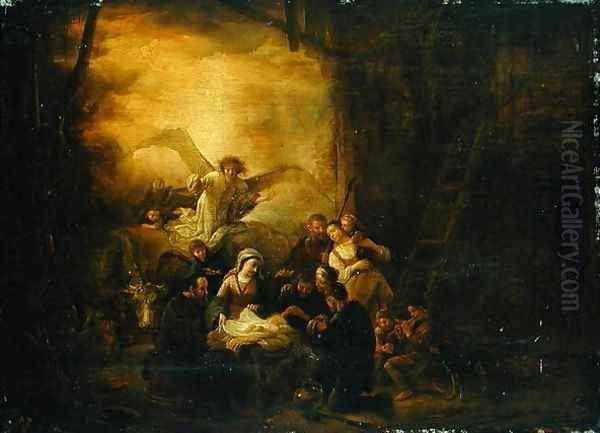
Jacob Willemsz. de Wet the Elder stands as a notable figure in the rich tapestry of Dutch Golden Age painting. Born around 1610 in the vibrant artistic center of Haarlem, he remained closely associated with the city throughout his life, eventually passing away there between 1671 and 1691, though 1675 is often cited based on later records. De Wet carved out a significant niche for himself primarily as a painter and draughtsman, specializing in historical, biblical, and mythological subjects. His work, while reflecting the broader trends of his time, possesses distinct characteristics that merit closer examination.
As an artist deeply embedded in the Haarlem school, De Wet's career trajectory followed a path familiar to many successful painters of the era. He engaged with the local artistic community, honed his craft, established a productive workshop, and contributed to the visual culture of the Netherlands through his numerous paintings and drawings. His legacy is tied not only to his own output but also to the influence he exerted as a teacher, shaping the next generation of artists.
Early Life and Artistic Formation
Details surrounding Jacob de Wet's earliest years and initial training remain somewhat sparse, a common challenge when studying artists from this period. However, it is firmly established that he was born in Haarlem around 1610. His artistic inclinations likely developed within this stimulating environment, which was home to masters like Frans Hals and Salomon van Ruysdael. The city's Guild of St. Luke, a crucial institution for artists, formally admitted De Wet as a member in 1632, marking his official entry into the professional art world of Haarlem.
His connection to the guilds extended beyond Haarlem. Records indicate that he also became a member of the Guild of St. Luke in Alkmaar in 1637. This suggests a broadening of his professional network and perhaps his sphere of operation, although Haarlem remained his primary base. These guild memberships were essential for artists, providing a framework for commissions, sales, and the regulation of apprenticeships.

Intriguing, albeit possibly apocryphal, stories about his early life have survived, notably through the writings of the later art historian Arnold Houbraken. Houbraken recounted an anecdote concerning De Wet's brother, identified as Pieter de Wet. According to one version of the tale, Pieter, on his deathbed, allegedly burned their shared sketchbooks to prevent Jacob from using the drawings for his own profit. Houbraken himself expressed skepticism about this story, suggesting it might be malicious gossip, but noted that another, perhaps more credible, version also circulated. Such tales hint at the competitive and sometimes complex relationships within artistic families of the time.
Artistic Style: Influences and Characteristics
Jacob de Wet the Elder's artistic style is most readily characterized by his focus on narrative subjects drawn from the Bible and classical mythology. His approach often involved relatively simple compositions, featuring a limited number of figures arranged to convey the story clearly and effectively. This narrative clarity was a hallmark of much history painting during the Dutch Golden Age.
A significant influence on De Wet's work was the towering figure of Rembrandt van Rijn. While the exact nature of their connection – whether De Wet studied directly with Rembrandt or simply absorbed his influence through observation – remains unclear, the stylistic echoes are undeniable. This is particularly evident in De Wet's use of chiaroscuro, the dramatic interplay of light and shadow, which imbues many of his scenes with heightened emotion and intensity. Rembrandt's impact on history painting in the Netherlands was profound, and De Wet was certainly receptive to his innovative techniques.
However, De Wet's style was not merely derivative. It possessed its own distinct qualities that set him apart from contemporaries such as Gerrit de Wet (his son) and Daniel Evertsz. Thiebaut. His early works, exemplified by pieces like The Raising of Lazarus (1633), show affinities with the slightly earlier generation of Amsterdam history painters known as the Pre-Rembrandtists, particularly figures like Pieter Lastman (Rembrandt's own teacher) and Jan Pynas. These artists favored detailed narratives, rich colors, and expressive figures.
Evolution of Style
Over the course of his career, De Wet's style underwent noticeable evolution. While biblical and mythological themes remained central, his later works often show an increased emphasis on the landscape settings. In some paintings, the figures, though still the nominal subject, appear somewhat diminished or pushed to the periphery, allowing the atmospheric depiction of the natural world to take precedence.

The color palette and handling of paint in these later works have sometimes been compared to the pastoral landscapes of artists like Aelbert Cuyp, known for his idyllic scenes bathed in warm, golden light. This suggests a shift towards a more atmospheric and perhaps less overtly dramatic mode of expression in his later years, integrating elements of landscape painting, another genre flourishing in the Netherlands at the time. His brushwork, often described as delicate, contributed to the overall effect of his compositions, whether focused on dramatic narrative or atmospheric landscape. The use of somewhat somber or "greyish" tones, characteristic of Baroque sensibilities, can also be observed in his oeuvre.
Major Works and Commissions
Jacob de Wet's prolific output included numerous paintings that found their way into collections across Europe. Among his most representative and frequently cited works is The Raising of Lazarus, dated 1633 and now housed in the Hessisches Landesmuseum in Darmstadt, Germany. This relatively early work showcases his engagement with dramatic biblical narratives and reflects the influence of the Pre-Rembrandtists and the emerging power of Rembrandt's style.
Another significant painting is The Feeding of the Five Thousand, dated 1644, held in the collection of the Hermitage Museum in St. Petersburg, Russia. This work demonstrates his ability to handle multi-figure compositions within a landscape setting, depicting a well-known biblical miracle. Such subjects allowed painters like De Wet to combine narrative storytelling with depictions of landscape and crowd scenes.
Beyond individual easel paintings, De Wet undertook larger commissions. One notable project involved a series of portraits depicting legendary and historical Kings of Scotland. These paintings were commissioned for the decoration of Holyrood Palace in Edinburgh, the official residence of the British monarch in Scotland. This commission indicates a level of recognition that extended beyond the Netherlands, although the execution of such large series often involved significant workshop participation.
The Workshop and Teaching Legacy
A crucial aspect of Jacob de Wet's career was his highly successful workshop in Haarlem. The studio system was central to art production in the Dutch Golden Age, allowing established masters to increase their output, train apprentices, and manage larger commissions. De Wet's workshop appears to have been particularly active and well-organized.
Art historical records suggest that De Wet trained a substantial number of pupils – perhaps as many as 37 over his career. This large number attests to his reputation as a teacher and the demand for training under his guidance. Among his documented students was Paulus Potter, who would go on to become one of the most celebrated Dutch painters of animals and landscapes. The training received in De Wet's studio would have provided a solid foundation in drawing, composition, and painting techniques.

The operation of such a busy workshop often involved standardized production methods. De Wet likely provided compositional sketches or models, which assistants and pupils would then help execute in paint. This collaborative process means that many unsigned works from the period are often attributed to the "circle of," "workshop of," or "follower of" Jacob de Wet. While this complicates precise attribution in some cases, it also highlights the efficiency and influence of his studio practice. His extensive collection of drawings and sketches served as important resources within the workshop and likely contributed to the dissemination of his style.
Relationships with Contemporaries and Reputation
Jacob de Wet operated within a dense network of artists in Haarlem and beyond. His most direct artistic familial connection was with his son, also named Jacob, sometimes referred to as Jacob de Wet II or potentially Gerrit de Wet (sources vary or show complexity in naming conventions, though Gerrit is mentioned as his son who learned from him and later established himself in Leiden). This son followed in his father's footsteps, receiving his initial training in the family workshop before embarking on his own career.
While clearly influenced by Rembrandt, the specific interactions between De Wet and the Amsterdam master are not documented. His style remained distinct from other contemporaries mentioned in records, such as Daniel Evertsz. Thiebaut (also referred to as Tierweert or Tielman), indicating the diversity of artistic approaches even within the same period and region. His early stylistic alignment with Pieter Lastman and Jan Pynas places him firmly within the trajectory of Dutch history painting.
De Wet enjoyed considerable respect within the Haarlem artistic community. His repeated appointments to positions within the Guild of St. Luke underscore his standing among his peers. Furthermore, his reputation extended to Amsterdam, where he was recognized for his expertise. In a notable instance, he was selected as one of the "best 15 critics" tasked with evaluating a consignment of Italian paintings being handled by the prominent art dealer Gerrit Uylenburgh. This role speaks volumes about his perceived connoisseurship and authority in matters of art.
Legacy and Art Historical Standing
Jacob Willemsz. de Wet the Elder holds a secure place in Dutch art history as a significant and prolific history painter based in Haarlem. His primary contribution lies in his extensive body of work focused on biblical and mythological narratives, executed in a style that absorbed the influence of Rembrandt while retaining its own character. His paintings are characterized by clear storytelling, often dramatic lighting, and an evolving integration of landscape elements.

His role as a teacher was equally important. Through his bustling workshop, he trained numerous artists, including the famous Paulus Potter, thereby extending his influence into the next generation. The standardized production methods employed in his studio, while sometimes blurring the lines of attribution, were indicative of successful workshop practices of the time and ensured a wide dissemination of works in his style.
Although primarily a painter, the wide circulation of his drawings and sketches, likely used as workshop models and perhaps disseminated through the active Amsterdam art market, led to him also being recognized, perhaps disproportionately, as an engraver or draughtsman in some later accounts. His works were collected both domestically and internationally, as evidenced by the Holyrood commission and the presence of his paintings in major European museums today.
Complexities remain, particularly regarding precise details of his life, the exact nature of his relationship with Rembrandt, and definitive attributions of all works associated with his studio. Scholarly debate sometimes arises concerning family identities, distinguishing between him, his son (Jacob/Gerrit), and potentially other related artists named De Wet. However, his core identity as a key Haarlem history painter, teacher, and respected figure in the Dutch Golden Age art world is well-established. He died in his native Haarlem, likely around 1675, leaving behind a substantial artistic legacy.